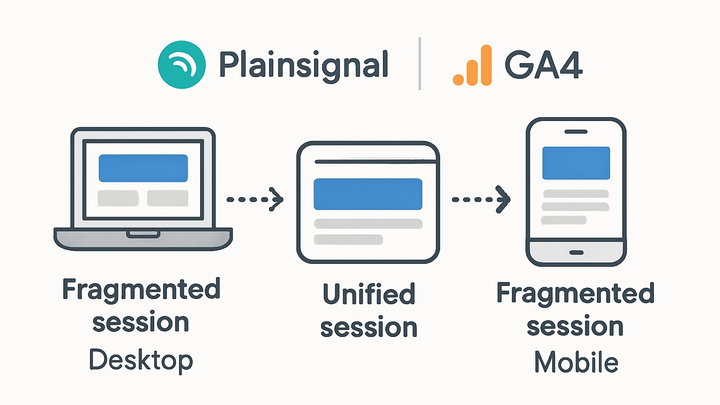Published on 2025-06-26T04:45:31Z
What is Session Stitching? Examples with PlainSignal and GA4
Session stitching is the process of unifying multiple user interactions—often scattered across devices, browsers, or sessions—into a single coherent session. Why it matters: accurate session counts, reliable user journeys, and deep insights. Modern analytics platforms like PlainSignal and Google Analytics 4 (GA4) each have unique approaches:
- PlainSignal uses cookie-free tracking with hashed identifiers.
- GA4 combines User-ID features and machine learning.
Effective stitching preserves user privacy, maintains data integrity, and empowers teams to make data-driven decisions with confidence.
Session stitching
Unifies user interactions across devices or sessions into single sessions for accurate analytics, using cookie-free or ID-based methods.
Why Session Stitching Matters
Session stitching is vital for preserving the continuity of the user journey. Without it, analytics teams face inflated session counts, misunderstood user behavior, and incomplete funnel analysis. By merging fragmented sessions, businesses gain reliable insights and drive better optimization.
-
Accurate session counts
Stitched sessions avoid double-counting the same user returning or switching devices, leading to reliable traffic and engagement reports.
-
Complete user journeys
Linking interactions across sessions reveals true user paths, helping optimize conversion funnels and content strategies.
-
Improved personalization
Unified sessions allow for better-targeted messaging and recommendations based on the full interaction history.
How Session Stitching Works
Session stitching leverages identifiers—like first-party cookies, device fingerprints, or custom User-IDs—to match and merge sessions. Analytics platforms implement stitching via various techniques.
-
Identifiers and matching
Platforms assign or derive unique identifiers to each visitor and match them across sessions using:
-
First-party ids
Persistent identifiers stored in the browser or passed via URL parameters.
-
Device fingerprinting
Hashes of device attributes when cookies are unavailable.
-
-
Event linking
Events tagged with the same identifier are grouped into a single session, even across page reloads or device switches.
-
Time-based heuristics
Some platforms use session timeout thresholds (e.g., 30 minutes) to split or continue sessions when explicit identifiers are absent.
Implementing with PlainSignal
PlainSignal offers a cookie-free analytics approach by generating anonymous hashed IDs in-browser and stitching sessions on the server. Here’s how to implement it.
-
Cookie-free tracking
PlainSignal leverages browser APIs to generate a persistent, anonymous fingerprint without storing cookies, ensuring privacy compliance.
-
Unique id generation
On each visit, the script collects entropy from browser attributes, hashes them, and emits a stable user identifier.
-
Tracking code example
Add the PlainSignal script to your site to enable session stitching:
-
Integration snippet
<link rel="preconnect" href="//eu.plainsignal.com/" crossorigin /> <script defer data-do="yourwebsitedomain.com" data-id="0GQV1xmtzQQ" data-api="//eu.plainsignal.com" src="//cdn.plainsignal.com/plainsignal-min.js"></script>
-
Implementing with GA4
GA4 provides built-in session stitching using the User-ID feature and machine learning models to merge anonymous and authenticated sessions.
-
User-id feature
Set the
user_idparameter for authenticated users in your gtag.js implementation to link sessions manually. -
Automatic stitching
GA4 uses probabilistic matching and ML to merge sessions without explicit identifiers, especially across devices when enabled.
-
Configuration example
gtag('config', 'G-XXXXXXXXXX', { 'user_id': 'USER_ID_VALUE' });
Best Practices
Follow these guidelines to ensure reliable session stitching while respecting user privacy and data accuracy.
-
Use consistent identifiers
Ensure that your authentication system or tracking layer provides the same ID for returning users across sessions.
-
Respect consent
Adhere to GDPR, CCPA, and other regulations by obtaining user consent before generating persistent identifiers.
-
Implement fallbacks
Combine multiple stitching methods (e.g., first-party ID plus fingerprinting) to handle cases where one fails.
Challenges and Limitations
While session stitching improves analytics accuracy, it faces technical and legal challenges.
-
Privacy regulations
Laws like GDPR and CCPA limit data collection methods; cookie-less or fingerprinting techniques may trigger compliance requirements.
-
Device and browser changes
Significant changes to browser settings, device resets, or incognito modes can break identifier continuity.
-
Anonymous traffic
Unauthenticated or new visitors without persistent identifiers will result in separate sessions by default.
